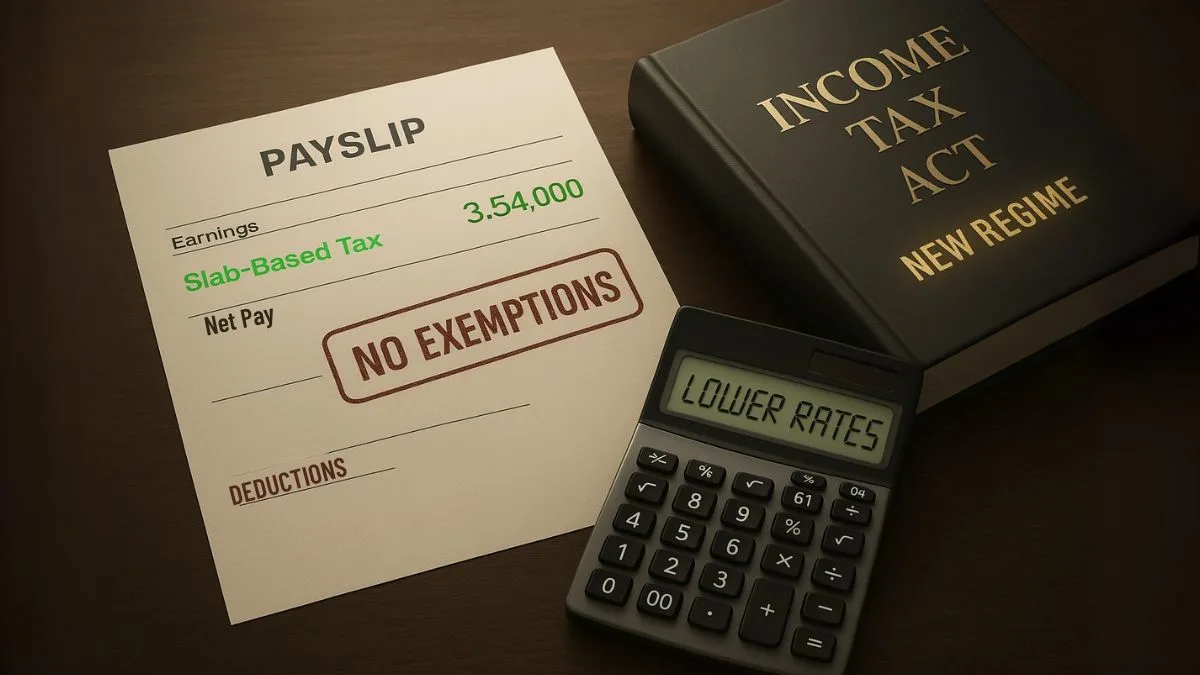
The Indian tax system has gone through several reforms, but none has sparked as much debate as the new tax regime. Introduced in Budget 2020, it was designed to simplify taxation by offering lower rates of taxes while eliminating the complexity of exemptions and deductions.
At first, taxpayers were cautious because they were comfortable with the old regime vis-à-vis new regime comparison. The old system rewarded planned investments, while the new one offered immediate relief through reduced tax rates. Over the years, however, the new tax regime has evolved, and with updates in Budget 2023 & 2024, it has become the default tax regime for most taxpayers.
What is the New Tax Regime?
The new tax regime provides individuals with the option to pay taxes at reduced slab rates. But here’s the catch – it eliminates most exemptions & deductions like those available under Sections 80C, 80D, and HRA benefits.
This means you don’t need to worry about investing in tax-saving products or maintaining detailed proofs for deductions. Instead, your tax liability is calculated purely based on your income.
For many, this is a relief as it reduces compliance. For others, especially those who have already structured their finances with long-term investments, the old regime may still be more beneficial."
New Tax Regime Slabs (AY 2025-26)
The government’s goal is clear: to make taxation easier. The slabs under the new tax regime are more evenly distributed.
|
Income Range (₹) |
Tax Rate (New Regime) |
|
0 – 3,00,000 |
Nil |
|
3,00,001 – 6,00,000 |
5% |
|
6,00,001 – 9,00,000 |
10% |
|
9,00,001 – 12,00,000 |
15% |
|
12,00,001 – 15,00,000 |
20% |
|
Above 15,00,000 |
30% |
With rebates under Section 87A, many taxpayers effectively pay zero tax on incomes up to ₹7 lakh. Recent updates now extend this, making incomes up to ₹12 lakh completely tax-exempt if deductions like standard deduction are factored in.
Also Read: The ₹1.5 Lakh Tax-Saving Secret Most Taxpayers Miss!
Benefits of the New Tax Regime
- Simplified Taxation: No need to remember dozens of exemptions.
- Lower Tax Rates: The new slabs ensure reduced liability for middle-class taxpayers.
- Flexibility: You are not forced to invest in specific schemes for saving taxes.
- Compliance-Friendly: Easy filing, fewer documents, & less paperwork.
- Attractive for Young Professionals: Those who are just starting careers often don’t invest heavily in tax-saving schemes."
Drawbacks of the New Tax Regime
- Loss of Deductions: Popular benefits like 80C (PF, ELSS, insurance), 80D (health insurance), and HRA are not available.
- Not Suitable for High Investors: Those who invest heavily in savings instruments may lose out.
- No Tailor-Made Benefits: Unlike the old regime, there’s no age-based higher exemption for senior citizens.
OLD REGIME VIS-À-VIS NEW REGIME
|
Feature |
Old Regime |
New Regime |
|
Tax Rates |
Higher |
Lower |
|
Exemptions/Deductions |
Available (80C, 80D, HRA, LTA, etc.) |
Not available |
|
Basic Exemption |
₹2.5L to ₹5L depending on age |
₹3L for all |
|
Best For |
People with investments, home loans, HRA |
People with fewer investments or young earners |
|
Compliance |
Complex |
Simple |
This comparison shows that the old regime vis-à-vis new regime decision is not one-size-fits-all. It depends on your financial planning, age, & investment habits.
Also Read: Physically Handicapped Allowance Exemption in Income Tax
Example to Understand the Difference
Let’s compare Mr. Arjun, who earns ₹12 lakh annually.
- Under Old Regime:
- Investments (80C): ₹1.5 lakh
- Health Insurance (80D): ₹25,000
- Home Loan Interest: ₹2 lakh
- Taxable Income: ₹8.25 lakh
- Tax Liability: Lower because of deductions
- Under New Regime:
- No deductions considered
- Taxable Income: ₹12 lakh
- Tax Liability: Based on lower slab rates
For someone like Arjun with heavy investments, the old regime is better. But for a fresh graduate with no major savings, the new regime is far simpler & often cheaper.
Why the Government is Pushing the New Tax Regime
The new tax regime is becoming the default because it:
- Reduces the government’s burden of monitoring deductions.
- Promotes voluntary compliance.
- Makes taxation uniform & transparent.
- Helps salaried employees save without locking money in specific schemes."
It’s part of a larger move to simplify India’s tax system while ensuring that more people file their returns.
Practical Tips for Taxpayers
- Calculate Both: Before filing, calculate tax under both regimes to see which saves more.
- Use a Calculator: Online tax calculators make it easy.
- Review Investments: If you have heavy investments in 80C, 80D, etc., old regime may still win.
- Consider Age and Income: For senior citizens, the old regime still offers better relief.
- Stay Updated: Budget announcements frequently tweak slabs and rebates.
Also Read: Save Taxes While Funding Higher Education
Conclusion
The new tax regime offers lower rates of taxes but eliminates most exemptions and deductions. It is best suited for individuals who want simple compliance, reduced paperwork, and instant relief. With the government making incomes up to ₹12 lakh completely tax-exempt under certain conditions, it has become a strong alternative for the middle class.
However, the choice between the old regime vis-à-vis new regime is personal. Those with structured investments may stick with the old, while others may embrace the new.
💡 Confused about whether the new tax regime is right for you?
Visit Callmyca.com – our experts will calculate and compare both regimes for you, ensuring you save the maximum legally.











